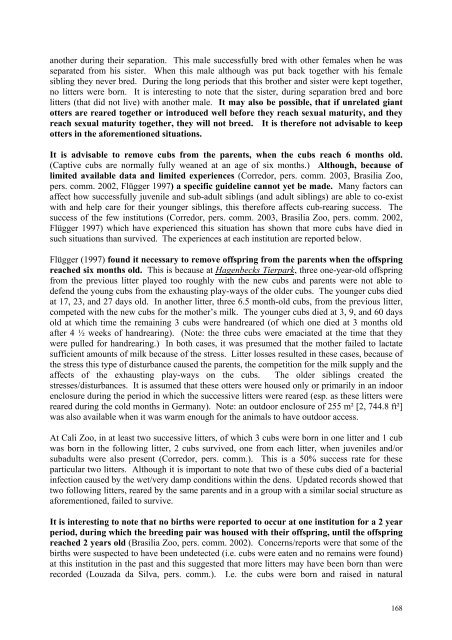International Giant Otter Studbook Husbandry and Management
International Giant Otter Studbook Husbandry and Management
International Giant Otter Studbook Husbandry and Management
You also want an ePaper? Increase the reach of your titles
YUMPU automatically turns print PDFs into web optimized ePapers that Google loves.
another during their separation. This male successfully bred with other females when he was<br />
separated from his sister. When this male although was put back together with his female<br />
sibling they never bred. During the long periods that this brother <strong>and</strong> sister were kept together,<br />
no litters were born. It is interesting to note that the sister, during separation bred <strong>and</strong> bore<br />
litters (that did not live) with another male. It may also be possible, that if unrelated giant<br />
otters are reared together or introduced well before they reach sexual maturity, <strong>and</strong> they<br />
reach sexual maturity together, they will not breed. It is therefore not advisable to keep<br />
otters in the aforementioned situations.<br />
It is advisable to remove cubs from the parents, when the cubs reach 6 months old.<br />
(Captive cubs are normally fully weaned at an age of six months.) Although, because of<br />
limited available data <strong>and</strong> limited experiences (Corredor, pers. comm. 2003, Brasilia Zoo,<br />
pers. comm. 2002, Flügger 1997) a specific guideline cannot yet be made. Many factors can<br />
affect how successfully juvenile <strong>and</strong> sub-adult siblings (<strong>and</strong> adult siblings) are able to co-exist<br />
with <strong>and</strong> help care for their younger siblings, this therefore affects cub-rearing success. The<br />
success of the few institutions (Corredor, pers. comm. 2003, Brasilia Zoo, pers. comm. 2002,<br />
Flügger 1997) which have experienced this situation has shown that more cubs have died in<br />
such situations than survived. The experiences at each institution are reported below.<br />
Flügger (1997) found it necessary to remove offspring from the parents when the offspring<br />
reached six months old. This is because at Hagenbecks Tierpark, three one-year-old offspring<br />
from the previous litter played too roughly with the new cubs <strong>and</strong> parents were not able to<br />
defend the young cubs from the exhausting play-ways of the older cubs. The younger cubs died<br />
at 17, 23, <strong>and</strong> 27 days old. In another litter, three 6.5 month-old cubs, from the previous litter,<br />
competed with the new cubs for the mother’s milk. The younger cubs died at 3, 9, <strong>and</strong> 60 days<br />
old at which time the remaining 3 cubs were h<strong>and</strong>reared (of which one died at 3 months old<br />
after 4 ½ weeks of h<strong>and</strong>rearing). (Note: the three cubs were emaciated at the time that they<br />
were pulled for h<strong>and</strong>rearing.) In both cases, it was presumed that the mother failed to lactate<br />
sufficient amounts of milk because of the stress. Litter losses resulted in these cases, because of<br />
the stress this type of disturbance caused the parents, the competition for the milk supply <strong>and</strong> the<br />
affects of the exhausting play-ways on the cubs. The older siblings created the<br />
stresses/disturbances. It is assumed that these otters were housed only or primarily in an indoor<br />
enclosure during the period in which the successive litters were reared (esp. as these litters were<br />
reared during the cold months in Germany). Note: an outdoor enclosure of 255 m² [2, 744.8 ft²]<br />
was also available when it was warm enough for the animals to have outdoor access.<br />
At Cali Zoo, in at least two successive litters, of which 3 cubs were born in one litter <strong>and</strong> 1 cub<br />
was born in the following litter, 2 cubs survived, one from each litter, when juveniles <strong>and</strong>/or<br />
subadults were also present (Corredor, pers. comm.). This is a 50% success rate for these<br />
particular two litters. Although it is important to note that two of these cubs died of a bacterial<br />
infection caused by the wet/very damp conditions within the dens. Updated records showed that<br />
two following litters, reared by the same parents <strong>and</strong> in a group with a similar social structure as<br />
aforementioned, failed to survive.<br />
It is interesting to note that no births were reported to occur at one institution for a 2 year<br />
period, during which the breeding pair was housed with their offspring, until the offspring<br />
reached 2 years old (Brasilia Zoo, pers. comm. 2002). Concerns/reports were that some of the<br />
births were suspected to have been undetected (i.e. cubs were eaten <strong>and</strong> no remains were found)<br />
at this institution in the past <strong>and</strong> this suggested that more litters may have been born than were<br />
recorded (Louzada da Silva, pers. comm.). I.e. the cubs were born <strong>and</strong> raised in natural<br />
168

















